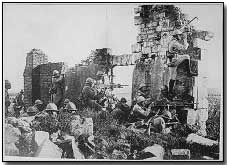Battles - The Second Battle of the Marne, 1918
 In what began as the last major German
offensive of the First World War, the Second Battle of the Marne developed
into a significant Allied victory. After it became clear that
the Germans had not only failed in their aim to win the war in this
offensive, but had in fact lost ground, a number of German commanders,
including
Crown Prince Wilhelm, believed the war was lost.
In what began as the last major German
offensive of the First World War, the Second Battle of the Marne developed
into a significant Allied victory. After it became clear that
the Germans had not only failed in their aim to win the war in this
offensive, but had in fact lost ground, a number of German commanders,
including
Crown Prince Wilhelm, believed the war was lost.
The battle took place over the course of 15 July-5 August 1918, in the final year of the war. Erich Ludendorff, effectively the German Chief-of-Staff (although Paul von Hindenburg was the ostensible commander), was convinced that the war could best be won by an attack in Flanders. To that end he determined to lure Allied forces from Belgium to the Marne in a huge diversionary attack, preparatory to a renewed offensive further north.
The second Marne offensive was launched on the back of an earlier push towards Paris which recaptured the Chemin des Dames ridge en route, a formidable position held by the Germans in 1914 and lost, at great cost to the French, during the 1917 Nivelle Offensive.
On the day of the offensive's launch, on 15 July, 23 German divisions of the First and Third Armies, under Mudra and Einem, attacked the French Fourth Army (commanded by Gouraud) to the east of Reims, while a further 17 divisions of the Seventh Army, under Boehm, assisted by the new Ninth Army under Eben, attacked the French Sixth Army (Degoutte) in the west.
In attacking Reims in this way, Ludendorff aimed to split the French forces. Joining the French were 85,000 U.S. forces plus troops from Sir Douglas Haig's British Expeditionary Force (BEF), although the majority of the latter's forces were located further north in Flanders.
 The
attack to the east quickly proved a failure and was halted at 11 am on the
first day without being resumed.
The
attack to the east quickly proved a failure and was halted at 11 am on the
first day without being resumed.
However the offensive to the west of Reims was more successful, breaking through the French Sixth Army and crossing the Marne at Dormans. Boehm, with the aid of six divisions, established a bridgehead nine miles in length and four in depth before the French Ninth Army, commanded by De Mitry and supported by British, American and Italian troops, halted his advance on 17 July.
With the Germans having ultimately failed in their efforts to break through, Ferdinand Foch, the Allied Supreme Commander, authorised a counter-offensive on 18 July, launching 24 divisions of the French army alone, in addition to U.S., British and Italian troops and some 350 tanks.
His aim was to eliminate the large German salient among the French lines. In this he was entirely successful. Mangin's French Tenth Army, and Degoutte's Sixth Army led the attack, advancing five miles on the first day alone. Berthelot's French Fifth Army and Eben's Ninth Army meanwhile launched subsidiary attacks in the west.
On 20 July the Germans ordered a retreat; by 3 August they were back where they had started at the launch of the great spring 1918 offensive: at the Aisne-Vesle rivers. The Allied counter-offensive was finally halted on 6 August by the now solidly entrenched Germans.
Casualties were high, more so among the German forces that the Allies. France suffered 95,000 casualties, Germany 168,000, with Britain incurring 13,000 losses and the U.S. 12,000.
As a consequence of the disastrous result in the Marne, Ludendorff's planned Flanders offensive was initially postponed, then entirely cancelled. No further large-scale attempt to win the war was undertaken.
To view maps charting the course of the final German offensive of the war click here and here.
Click here to read General Gouraud's appeal to his forces at the onset of the battle. Click here to read an extract from U.S. Commander-in-Chief John J Pershing's official report summarising U.S. participation in the battle. Click here and here to read semi-official German press statements published in July and August 1918 on the outcome of fighting at the Marne. Click here to read a German memoir focusing on the events of 15 July. Click here to read Pershing's Special Order of the Day, dated 27 August, in which he praised the role played by his forces. Click here and here to read contrasting statements regarding the effectiveness of the Allied counterattacks, issued by Ludendorff. Click here to read the official address given by French General Charles Mangin on 7 August 1915, directed to U.S. First and Second servicemen who, assisting Mangin's French Tenth Army, participated in the Allied counter-attacks launched on 18 August. Click here to read the view later given by Mangin concerning the turning point of the Allied counterattack at the Marne. Click here to read the official address given by French Sixth Army General Jean Degoutte to French and U.S. troops towards the close of the battle, on 9 August 1918, in which he praised the conduct of American forces. Click here to read an account by Karl Rosner of how news of the battle was received by the Kaiser.
Photographs courtesy of Photos of the Great War website
Bulgaria mobilised a quarter of its male population during WW1, 650,000 troops in total.
- Did you know?
